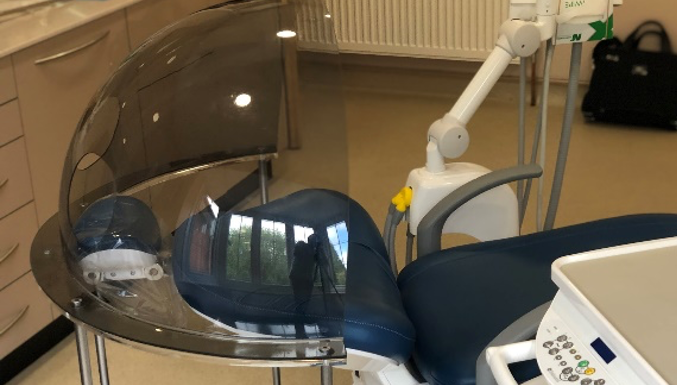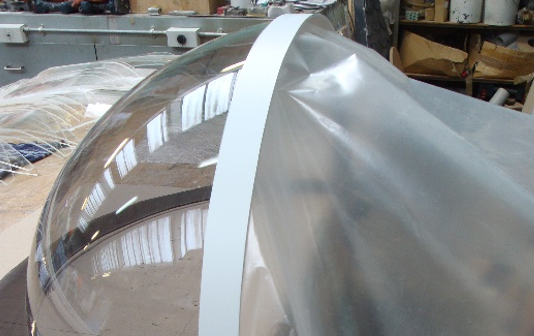
An innovative easy solution to prevent clinicians’ exposure to airborne particles from dental procedures using redirection and trapping.
Aerosol clouds carry airborne particles including SARS-CoV-2, the virus that causes COVID-19.
The NHS standard operating procedure advises contact precautions to prevent and control infection transmission via direct or indirect contacts. This is the most common route of infection transmission. To mitigate the risk, regulators recommend dental clinicians use level three PPE. But current supply shortage, and difficulties with fitting and wearing, remain problematic for dental practices.
The NHS also recommends droplet precautions and airborne precautions. This prevents and controls infection transmission over short distances (one to two metres) via droplets (>5μm) and aerosols (≤5μm), without necessarily having close contact. Infectious particles can stay airborne for a long time after a procedure. Therefore, regulators also recommend practices leave a sufficient time gap (~60 minutes) between each procedure that makes operations economically unviable.
As dental clinics open after the COVID-19 lockdown, there remains confusion over measures needed to create a safe operational environment. Because of inadequate access to suitable PPE, as well as insufficient guidelines and regulations, healthcare clinicians are improvising protective barriers to reduce risks associated with the aerosol spread. In such uncertain times therefore, clinicians must take common sense measures. Some above and beyond the formal guidelines issued by different authorities.
Dr Hadi Sanei and Dr Korosh Majidi of Hook Dental Club are introducing and manufacturing a new barrier design, ‘Aero Shield‘. It will increase protection measures for dental clinicians. A simple design, but effective!
What does Aero Shield look like?
Aero Shield is a see-through, one-piece quarter hemisphere shape. The manufacturers make it from cast acrylic sheet, polymethyl methacrylate (PMMA). Two circular ports also provide easy access to the patient. The authors created a plastic cover that can easily hook onto the hemisphere during procedures. This creates a closed space to trap particles.

Results from the tests show that Aero Shield redirects and traps the aerosol and splatter to a more concentrated area within the hemisphere. This reduces the level of aerosol particle concentration (floating airborne particles) in the room. It drew two distinct benefits:
Clinicians do not directly expose themselves to aerosols and splatters
There is a growing concern that even by using PPE level three, there is still a risk of cross contamination due to the large amount of aerosol and splatters particles that sit on the actual PPEs during procedures.
Less time required to trap and clean airborne particles. Potentially less time gap required between each procedure (ie each patient)
In a normal practice, airborne particles float around the room until they reach a surface so they can be cleaned/wiped up. This means a high risk of cross contamination as the particles contact all other equipment in the rooms. Also, clinicians are exposed to infectious particles for a long period of time, even after a procedure and when most probably they have removed their PPEs.
Regulators therefore require practices to leave sufficient time (~60 minutes) gap between each procedure. That makes dentistry economically unviable.
By redirecting and trapping the airborne particles to a much more concentrated area within the hemisphere, Aero Shield also enables standard dental set suction motors to vacuum up most of the particles. It enables clinicians to clean and wipe up the particles trapped with the shield surface safer and quicker. Measures that could potentially result in less time required between procedures.
‘As part of our rigorous tests of Aero Shield, we simulated a 15-minute AGP in two scenarios with and without shield. After each procedure, we counted the particle concentration size for 60 minutes. There was 45 minutes time difference for the two scenarios to reach a same and safe level of concentration, which is significant,’ Dr Sanei said.
He continued: ‘Aero Shield is not an ultimate solution to the risk we are facing associated to the cross contamination of COVID-19, but certainly is a common sense measure that needs to be taken.’
Based on his own personal experience, Dr Majidi said: ‘I used Aero Shield to see my orthodontic patients for the last 10 days and found it fairly comfortable to work with. Its ergonomic design helps to keep your correct posture whilst providing direct vision. The access ports are particularly of great help during the long sessions as you can rest your arms on them.
‘The other great feature is the mobility feature of the shield, which you can easily change the position of without the need for any adjustment. All patients were very relaxed during the treatment session and we managed to perform four-handed orthodontics without any difficulty. I personally recommend this shield for hygienists.’
For more information about Dr Sanei and Majidi’s innovative new barrier, simply visit www.hookdentalclub.com/aero-shield.
Read more about the Aero Shield at www.aero-shield.co.uk.


